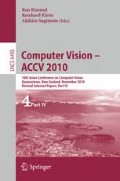Abstract
We extract local empirical templates and density ratios from a large collection of surveillance videos, and develop a fast and low-cost scheme for people counting. The local empirical templates are extracted by clustering the foregrounds induced by single pedestrians with similar features in silhouettes. The density ratio is obtained by comparing the size of the foreground induced by a group of pedestrians to that of the local empirical template considered the most appropriate for the region where the group foreground is captured. Because of the local scale normalization between sizes, the density ratio appears to have a bound closely related to the number of pedestrians that induce the group foreground. We estimate the bounds of density ratios for groups of different numbers of pedestrians in the learning phase, and use the estimated bounds to count the pedestrians in online settings. The results are promising.
Access this chapter
Tax calculation will be finalised at checkout
Purchases are for personal use only
Preview
Unable to display preview. Download preview PDF.
References
Barandiaran, J., Murguia, B., Boto, F.: Real-time people counting using multiple lines. In: WIAMIS, pp. 159–162 (2008)
Yu, S., Chen, X., Sun, W., Xie, D.: A robust method for detecting and counting people. In: ICALIP, pp. 1545–1549 (2008)
Albiol, A., Mora, I., Naranjo, V.: Real-time high density people counter using morphological tools. IEEE Trans. ITS 2, 204–218 (2001)
Park, H., Lee, H., Noh, S., Kim, J.: An area-based decision rule for people-counting systems. In: Gunsel, B., Jain, A.K., Tekalp, A.M., Sankur, B. (eds.) MRCS 2006. LNCS, vol. 4105, pp. 450–457. Springer, Heidelberg (2006)
Haritaoglu, I., Harwood, D., Davis, L.S.: W4: Real-time surveillance of people and their activities. IEEE Trans. PAMI 22, 809–830 (2000)
Zhao, T., Nevatia, R.: Bayesian human segmentation in crowded situations. In: CVPR, pp. 459–466 (2003)
Elgammal, A.M., Davis, L.S.: Probabilistic framework for segmenting people under occlusion. In: ICCV, pp. 145–152 (2001)
Zhao, X., Dellandrea, E., Chen, L.: A people counting system based on face detection and tracking in a video. In: AVSS, pp. 67–72 (2009)
Li, M., Zhang, Z.X., Huang, K., Tan, T.N.: Estimating the number of people in crowded scenes by mid based foreground segmentation and head-shoulder detection. In: ICPR, pp. 1–4 (2008)
Kelly, P., O’Connor, N.E., Smeaton, A.F.: Robust pedestrian detection and tracking in crowded scenes. Image Vision Computing 27, 1445–1458 (2009)
Davies, A.C., Yin, S.A.M., Velastin, S.A.: Crowd monitoring using image processing. Electron. Commun. Eng. J., 37–47 (1995)
Marana, A.N., Velastin, S.A., Costa, L.F., Lotufo, R.A.: Automatic estimation of crowd density using texture. J. Safety Sci. 28, 165–175 (1998)
Kilambi, P., Ribnick, E., Joshi, A.J., Masoud, O., Papanikolopoulos, N.: Estimating pedestrian counts in groups. In: CVIU, vol. 110, pp. 43–59 (2008)
Chan, A.B., Morrow, M., Vasconcelos, N.: Analysis of crowded scenes using holistic properties. In: Int’l Workshop on PETS, pp. 101–108 (2009)
Albiol, A., Silla, M.J., Albiol, A., Mossi, J.M.: Video analysis using corner motion statistics. In: Int’l Workshop on PETS, pp. 31–37 (2009)
Stauffer, C., Grimson, W.L.R.: Learning patterns of activities using real-time tracking. IEEE Trans. PAMI 22, 747–757 (2000)
Sharma, P.K., Huang, C., Nevatia, R.: Evaluation of people tracking, counting and density estimation in crowded environments. In: Int’l Workshop on PETS, pp. 39–46 (2009)
Stalder, S., Grabner, H., Gool, L.V.: Exploring context to learn scene specific object detectors. In: Int’l Workshop on PETS, pp. 63–70 (2009)
Cucchiara, R., Grana, C., Piccardi, M., Prati, A., Sirotti, S.: Improving shadow suppression in moving object detection with hsv color information. In: ITSC, pp. 334–339 (2001)
Author information
Authors and Affiliations
Editor information
Editors and Affiliations
Rights and permissions
Copyright information
© 2011 Springer-Verlag Berlin Heidelberg
About this paper
Cite this paper
Hung, D.H., Chung, SL., Hsu, GS. (2011). Local Empirical Templates and Density Ratios for People Counting. In: Kimmel, R., Klette, R., Sugimoto, A. (eds) Computer Vision – ACCV 2010. ACCV 2010. Lecture Notes in Computer Science, vol 6495. Springer, Berlin, Heidelberg. https://doi.org/10.1007/978-3-642-19282-1_8
Download citation
DOI: https://doi.org/10.1007/978-3-642-19282-1_8
Publisher Name: Springer, Berlin, Heidelberg
Print ISBN: 978-3-642-19281-4
Online ISBN: 978-3-642-19282-1
eBook Packages: Computer ScienceComputer Science (R0)

